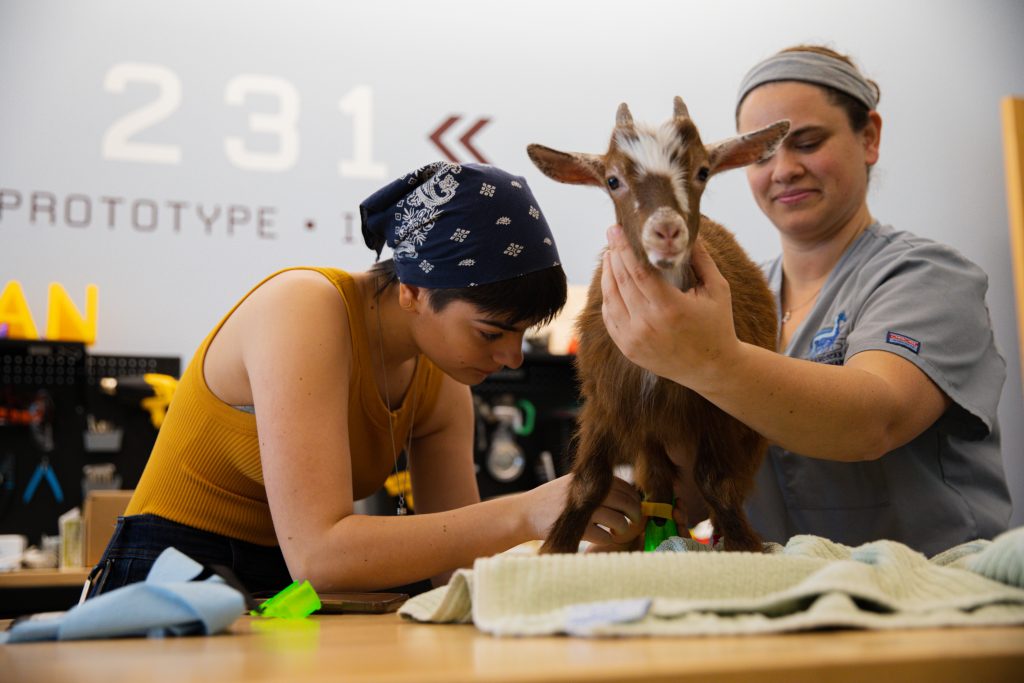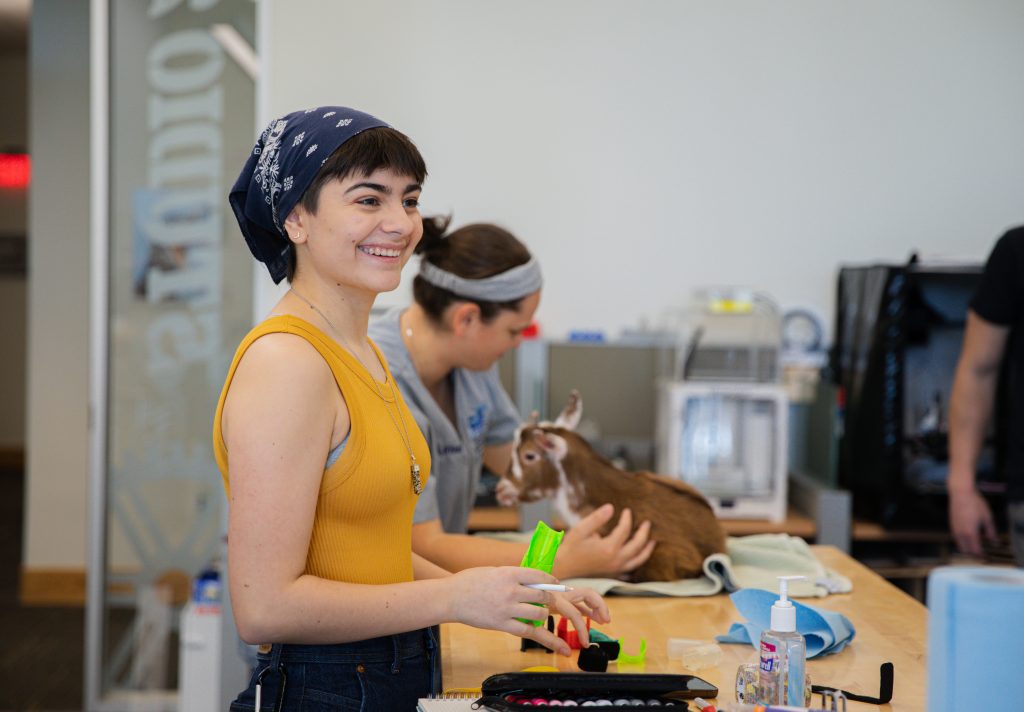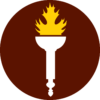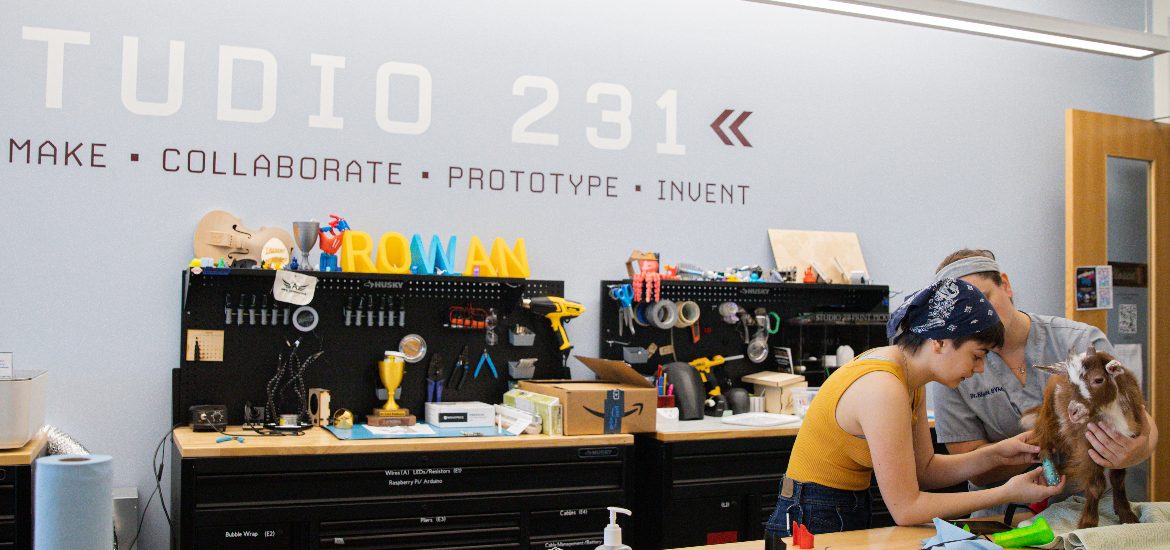An interdisciplinary, collaborative space, Studio 231 within the School of Innovation & Entrepreneurship helps to bring the best ideas to life – including, this time, giving a new lease on life to a baby goat who was unable to walk.
The story of Fortunato the goat highlights the ingenuity – not to mention the impact – of leveraging this student-led and student-run experiential learning lab and makerspace within the Rowan community. A hub for collaboration, ideation, rapid prototyping and research, the newly created Schreiber School of Veterinary Medicine partnered with Studio 231 to create working legs for this Nigerian Dwarf goat with septic arthritis in his hind feet, which caused him to lose the feet.
Dr. Matthew Edson, founding dean of the veterinary school, had previously toured Studio 231 and knew that this resource would be valuable for their work, opening up the possibility of printing 3D models for the vet school.
Fortunato’s owners were told he should be euthanized. Dr. Edson had a different recommendation.
With an email entitled “Goat Legs” Dr. Edson reached out to the Henry M. Rowan College of Engineering, asking to partner with Studio 231 to create new working legs for Fortunato. That email found its way to Addison Deckert, a sophomore mechanical engineer major from Gannett Park, MD, and Vincent Gallo, a junior mechanical engineering major from Cinnaminson, NJ, who then worked on the project.

Even with a team put together and the drive to create a perfect model, a series of obstacles remained in the way. How would they build legs that would expand as Fortunato grew? How could Addison and Vincent, who rarely worked the same shifts, best collaborate? Which approach, which idea, was the right one to pursue?
The emotional attachment to Fortunato, the intensity of working toward saving a life, and working with a deadline certainly brought out the best in all involved. Several questions needed to be answered for success to be achieved. Vincent shed some light on some of them, “What should we keep in mind? What part of the leg should we try and stay away from? So that’s not like a big pressure point when the goat is walking; how much support does it really need?”
The shape of Fortunato’s body created an interesting challenge that needed to be addressed. Addison revealed, “One of the hardest things we had with designing was figuring out how to keep the boot on because sometimes just like a friction fit and wrapping it real tight isn’t the best solution. And he actually has a tendon running along the upper part of his leg, so we couldn’t attach anything to it. So we went through a lot of different designs.”
Another element of the challenge the project posed was what materials could and could not be used, as they had to be animal friendly. After looking at several different options that combine plastic and 3D printing materials, they opted for TPU, a material that would hold up in the sun, in water, and still remain comfortable for Fortunato.
After switching the material for the laces to a thinner material, Fortunato was ready to test out the design. Because his leg hindered him from going outside, he was hesitant to touch the world outside, but on a beautiful day, dreams came true. Fortunato came to life running around and hopping on his new prosthetic – the design worked.
The joy for the team was moving, even though Vincent missed the moment due to having to take a test; Addison had this to say about the moment, “Actually being able to see a prototype that I made on Fortunato and working and actually giving him something he didn’t have before is indescribable.” The collaboration not only saved a life but opened the door on saving more down the line. Both students and the rest of the team were showered with praise from the new dean, “We couldn’t be happier with the whole team that worked on this. We came in the first day to a back of a goat’s leg drawn on the board. They had researched the anatomy. They had already come up with a couple of different models that they planned to use. They were really well prepared, but I think they were also able to be creative and entrepreneurial in their approach and adjust to the challenges and come up with a really nice finished project.”

In terms of what comes next, different answers were given. The success of creating a prosthetic certainly opens up opportunities for students to work with the new school, Dean Edson says, “This is the sort of project that we want to do. We want to think outside of the box, involve other departments, other agencies, and all come together to solve problems like this for the betterment of both animal health and human health. And again, this was a perfect example of how we want to do that.”
This project certainly captured the mind of Addison and what she thought was possible, even expressing an interest in working ducks for similar projects in the future. Accomplishing the ability to help aid an animal to walk extends the reality of what is deemed achievable and with students such as Vincent and Addison leading the way in innovation, no project is too big to dream about at Rowan.
None of this would have been possible without not only Dean Edson, Vincent and Addison but several professors, faculty, and others who helped guide the project along. Working as a team to achieve a goal for something greater than an individual’s ambition helps kindle the wonder in students. This is summed up through Addison, ““It was really amazing and it makes me really want to do engineering because sometimes you doubt it after doing 15 hours of homework and three all-nighters and failing a test and all those types of things, it really makes you doubt. But do I want to actually design something new and build something that actually helps people? Yes. I think Rowan’s really trying to push that mindset.”
Like what you see?
Story by:
Thomas Ubelhoer, sophomore political science and international studies double major



